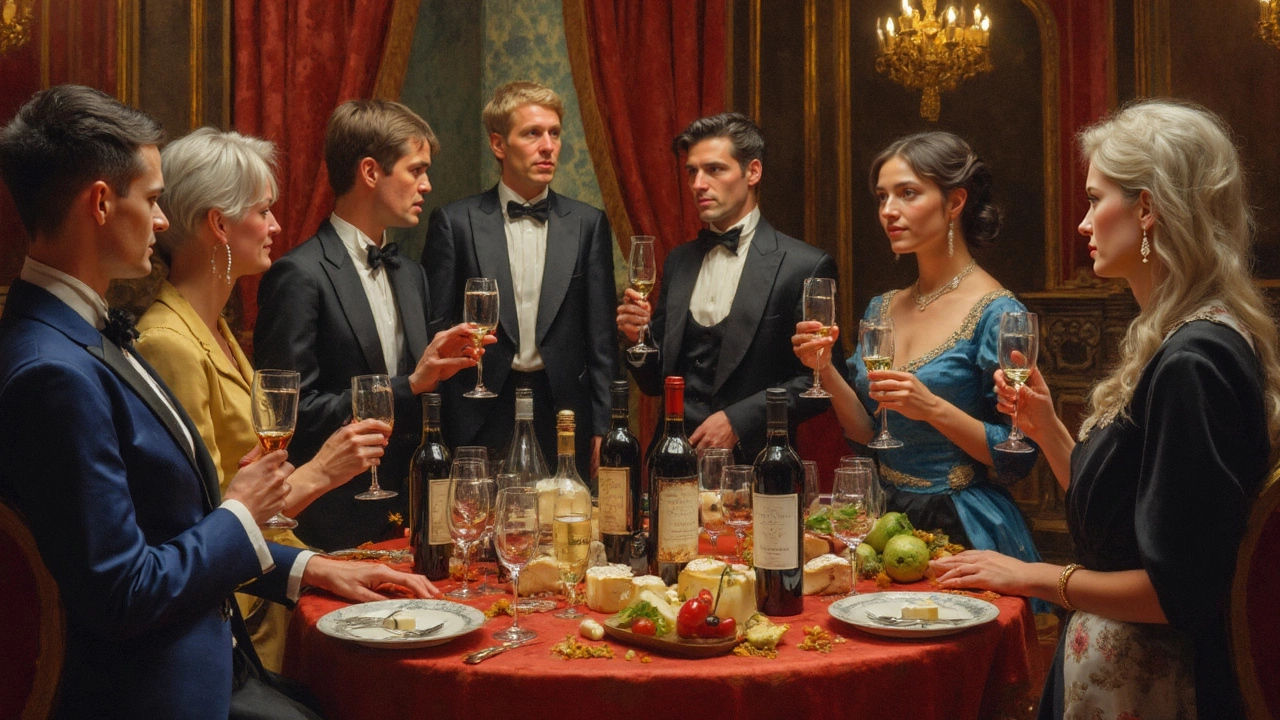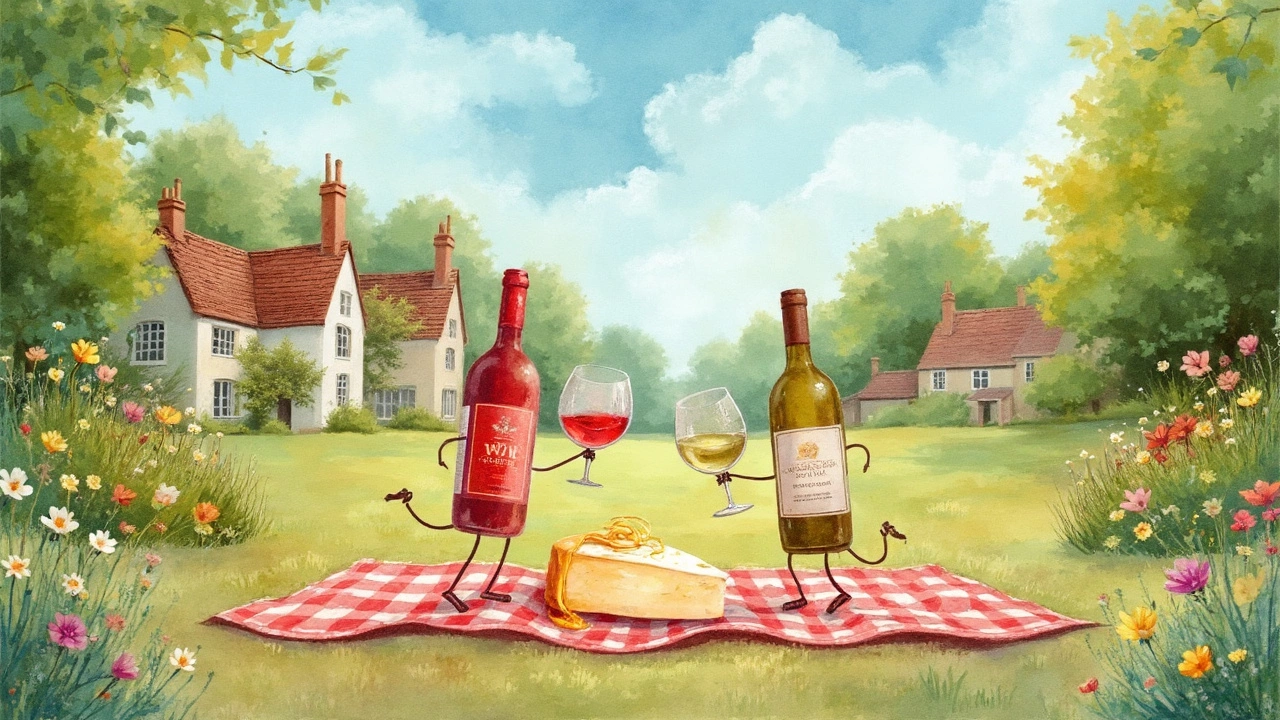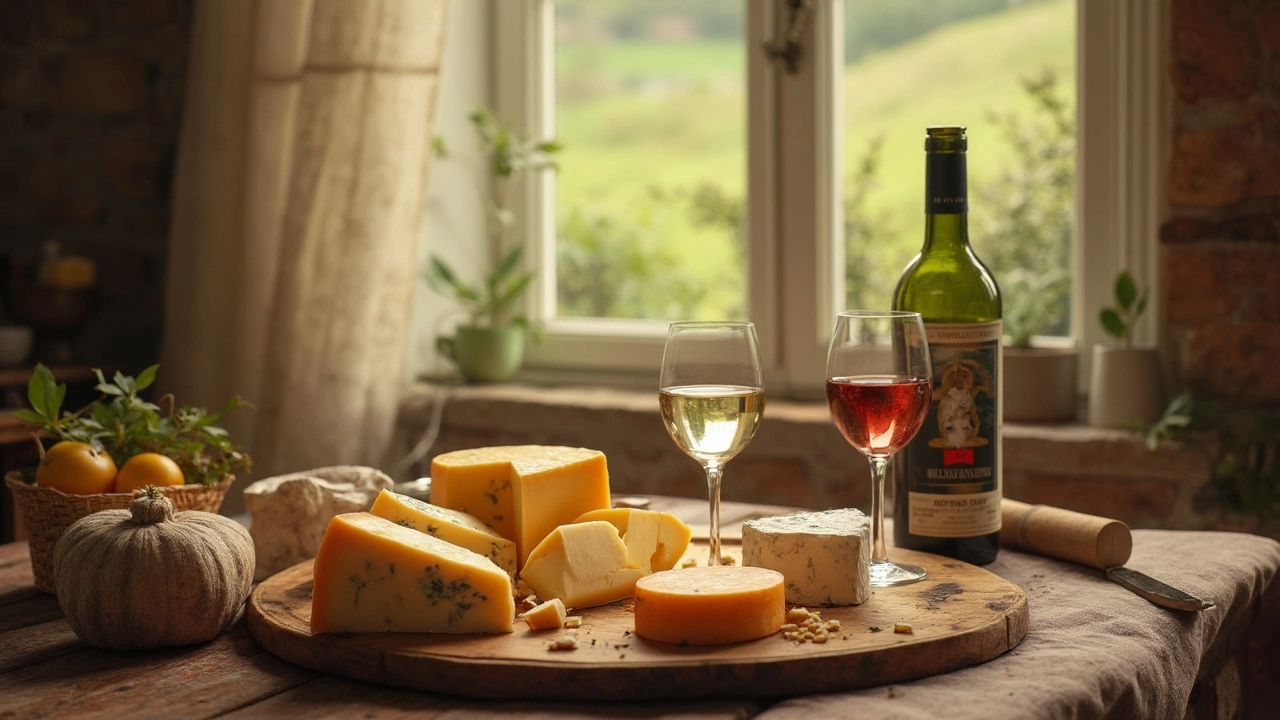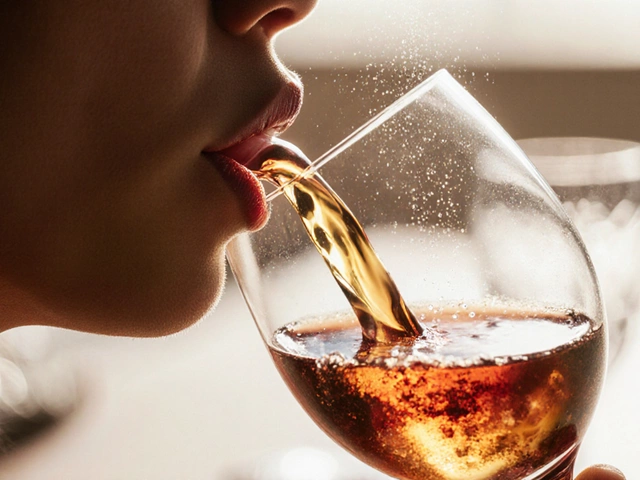Pairing wine and cheese isn't just for the fancy folks—it's something anyone can enjoy. But when you're standing in front of the wine rack, trying to decide whether to grab a bottle of white or red to go with your cheese spread, things can get a bit tricky. Let's start with the basics: understanding why some wines go better with certain cheeses.
White wines are often seen as the go-to choice for cheese pairings. Their acidity and lighter body can cut through the rich, creamy textures of cheese, creating a refreshing balance. Think of a sharp, tangy cheddar enjoying a nice chat with a crisp Sauvignon Blanc—it's like having a palate-cleansing break between bites.
On the flip side, red wines, with their bold flavors and tannins, can stand up to stronger cheeses. A robust red like Cabernet Sauvignon brings out the best in aged cheeses like gouda or blue cheese. It's all about finding a match where neither the wine nor cheese overpowers the other.
Now, you might think, 'Just stick to these rules, right?' But here's where it gets fun—you can experiment! Try mixing and matching to see what works for you. After all, everyone's palate is unique. So, when in doubt, why not grab both a red and a white? Your taste buds will thank you.
- Understanding the Basics of Pairing
- The Case for White Wine
- Why Red Wine Works
- Common Pairing Pitfalls
- Tips for Creating Your Perfect Combo
Understanding the Basics of Pairing
When you're getting into pairing wine with cheese, it's like matchmaking for flavors. First, it's important to think about the basics. You’re not trying to follow strict rules; instead, you’re aiming to create harmony between the wine and the cheese. Let's break down what you need to know.
Balance is Key
The key idea here is balance. You wouldn't want a delicate white wine like a Pinot Grigio to be paired with an intense blue cheese because the wine would be completely overshadowed. Conversely, a robust red wine could completely drown out the subtleties of a mild brie.
Think About Weight
A good starting point is to consider the weight and intensity of both the wine and the cheese. Light, soft cheeses often go well with white wines because the vibrant acidity of white wines can lift the creamy textures. On the other hand, harder and aged cheeses have the flavor punch to stand up to bolder reds.
Sweet and Salty Combos
Don't overlook the power of a salty and sweet pairing. Sweet wines like a Riesling can pair remarkably well with salty cheeses such as a tangy Roquefort. The sweetness in the wine mellows out the saltiness, making each bite and sip more delightful than the last.
Considering Texture
Texture also plays a part. A cheese like a triple cream that has a rich, buttery texture pairs nicely with wines that have a bit of acidity to cut through the richness. White wines, with their natural acidity, often do this job well.
Once you grasp these basic principles, you're ready to explore. Don't be afraid to try new combinations. Remember, the best pairing is the one that you enjoy the most!
The Case for White Wine
When it comes to cheese pairing, white wine often steals the show. Why? It's their vibrant acidity and lighter body that make them a great match for many types of cheese. Imagine the brightness of a good white wine slicing through the creamy richness of brie—it’s like a refreshing palate cleanser with every sip.
The Role of Acidity
One major reason white wine is a preferred choice is due to its higher acidity compared to reds. This acidity can cut through the fat in cheese, balancing out the flavors. For example, a nicely chilled Sauvignon Blanc pairs wonderfully with the earthy flavors of goat cheese, enhancing the cheese's tangy notes without overwhelming your taste buds.
Matching Lighter Flavors
Another cool thing about white wines is their ability to match with milder cheeses. A crisp Chardonnay pairs beautifully with mild cheeses like mozzarella or fresh ricotta. The key here is not allowing the wine to overpower the cheese's delicate flavors.
Sweet and Salty Combinations
If you’re into sweet and salty pairings, consider a Riesling with a savory blue cheese. The natural sweetness of Riesling complements the saltiness of blue cheese, creating a balance that’s surprisingly delicious.
Don't just take my word for it—next time you’ve got a cheese platter in front of you, pour yourself a glass of white and experiment. You’ll quickly see why white wine remains a popular choice in the world of wine and cheese pairing. Here are a few classic pairings to get you started:
- Sauvignon Blanc with Goat Cheese
- Chardonnay with Camembert
- Riesling with Blue Cheese
- Pinot Grigio with Feta

Why Red Wine Works
Alright, so you're thinking of grabbing a red wine to go with your cheese. Good news—you're on the right track! Red wine, with its rich and robust characteristics, has some unique qualities that make it a solid partner for certain cheeses.
The Role of Tannins
The first thing to know about reds is tannins. You've probably heard this term tossed around, but why does it matter? Tannins are compounds found in grape skins that give red wines that slight puckering sensation. They add structure to the wine, making it a great match for bold cheeses like aged cheddar or gouda, since they can handle the richness without getting overshadowed.
Flavors That Compliment
Red wines often have more complex flavors than whites. A red wine like a Merlot or a Cabernet Sauvignon can have notes of dark berries, cherries, or even cocoa. These flavors can bring a whole new dimension to your cheese experience. Imagine enjoying a creamy Brie with a Merlot—the fruity notes could cut through the buttery texture, creating an amazing balance.
Factors to Consider
Pairing isn't a one-size-fits-all, though. The key to figuring out the right red for your cheese is understanding the intensity. Strong red wines can sometimes overpower delicate cheeses, so it's about finding a happy middle ground. Use your nose and taste buds to guide you.
| Red Wine | Recommended Cheese |
|---|---|
| Cabernet Sauvignon | Aged Gouda |
| Merlot | Cambozola |
| Pinot Noir | Gruyère |
So, what are you waiting for? Grab a bottle of red wine and a selection of your favorite cheeses, and start experimenting. You might just stumble upon your personal perfect pairing.
Common Pairing Pitfalls
Stepping up your wine pairing game isn't just about knowing what works. It's also about understanding what might not hit the mark. Whether you're a novice or seasoned sipper, avoiding these common mistakes can make a world of difference.
Overpowering Flavors
One of the biggest pitfalls is choosing wines with flavors that overpower the cheese. If you've got a strong, rich blue cheese, pairing it with a delicate white wine might feel like killing its vibe. Red wine or a full-bodied white like Chardonnay could be a better match.
Ignoring Acidity Levels
Another slip-up is ignoring acidity. Wines with high acidity tend to pair better with creamy cheeses, as they cut through richness. A high-acid white wine like Sauvignon Blanc can be your best friend when paired with a creamy brie.
Temperature Terrors
Temperature plays a key role, too. Serving wines too cold or cheeses too warm can numb their flavors. Wine expert, Jane Smith, says,
"Room temperature wine and slightly cool cheese can unlock the full taste potential of your pairing experience."
Not Considering the Region
Ever heard the saying, 'What grows together, goes together'? This rings true for wines and cheeses from the same region. They often share similar flavor profiles, making them natural partners. Got a bottle of Italian Chianti? Look for Italian cheese like Parmigiano-Reggiano to pair it with.
By watching out for these common errors, you'll be well on your way to creating memorable wine and cheese moments. Who knew a little know-how could make such a big difference in your next tasting adventure?

Tips for Creating Your Perfect Combo
Want to nail that wine pairing? Here are some tips to make sure your cheese board and wine are the talk of the party. Don't stress—it's all about having fun and discovering flavors that make you go "wow"!
1. Start Simple
When you're just starting out, keep it simple. Choose one white wine and one red wine. This gives you a good base to work from and helps your guests, or yourself, explore flavors without overwhelming the senses.
2. Match Intensity
Light wines go with light cheeses, and strong wines pair well with strong cheeses. A fresh, young goat cheese pairs nicely with a zesty Sauvignon Blanc, while a robust aged gouda loves a full-bodied Cabernet Sauvignon. Remember, neither should outshine the other!
"Pairing cheese and wine is more like art than science. Trust your instincts!" — Gary Vaynerchuk, Wine Expert and Entrepreneur
3. Think About Texture
Texture matters. Lighter cheeses like mozzarella or brie work well with white wine, while creamy, rich textures like Camembert are lovely with a light red like Pinot Noir. It's all about enhancing how the cheese feels in your mouth with the wine.
4. Don’t Be Afraid to Experiment
If classic pairings are the reliable mainstays, then experimenting is your playground. Mix a sweet wine with a salty cheese or try matching regional wines with cheeses from the same area. You might discover a personal favorite!
5. Create a Balanced Board
When creating a cheese board, variety is key. Include a mix of flavors, textures, and milk types (cow, sheep, goat) and let your guests roam the spectrum of tasting experiences. Balance with a mix of mild and bold options to cater to all palates.
Bonus Tip: Serve at the Right Temperatures
Cheese develops flavor and aroma at room temperature, so take it out of the fridge about an hour before serving. Wines, on the other hand, depend on type—generally, whites are slightly chilled, and reds are often best at cool room temperature.
- Cheese: Room temperature
- White Wine: Slightly chilled (around 45-50°F)
- Red Wine: Cool room temperature (60-65°F)
Give these tips a try next time you're hosting or just chilling with some cheese and wine. It's amazing how a bit of thought can turn a snack into an experience!


